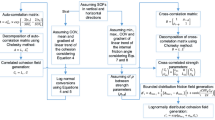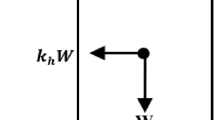Abstract
In recent years, spatial variability modeling of geotechnical parameters using random field theory is gaining strength in the reliability based analysis of geotechnical problems. Slope stability analysis of highly weathered rock slope requires proper modeling of geotechnical parameters with due consideration of extent of weathering and overburden pressure. The present study demonstrates the approach for spatial variation modeling of geotechnical parameters and reliability analysis based stability assessment of highly weathered rock slope by considering a typical case of height = 5.0 m and slope angle of 30°. Commercially available software FLAC 5.0, via inbuilt FISH function, has been utilized for the numerical analysis purpose with the assumption that highly weathered rock mass can be analyzed within the framework of the concept of equivalent continuum model. A parametric study is performed to investigate the following: (i) influence of coefficients of variation of geotechnical parameters and (ii) auto-correlation distances on the reliability analysis results. For the reliability analysis, information on mean and variance of output parameter, i.e., factor of safety of the given rock slope is obtained from 2000 Monte Carlo simulations and results are utilized with first order reliability method to obtain reliability index values. The results of the analysis clearly demonstrated that numerical modeling of spatially varying geotechnical parameters gives more realistic treatment to the property variation of a natural material and stability assessment in reliability analysis framework is more comprehensive than conventional limit equilibrium based factor of safety approach.



Similar content being viewed by others
References
Singh B, Goel RK (1999) Rock mass classification: a practical approach in civil engineering. Elsevier publication, Amsterdam, p 267
Cornforth DH (2005) Landslides in practice. Wiley, Hoboken
Hoek E, Bray J (1981) Rock slope engineering, rev. 3rd edn. Institution of Mining and Metallurgy, London
Duncan CW, Christopher WM (2004) Rock slope engineering: civil and mining, 4th edn. Spon Press/Taylor & Francis Group, London/New York
Charles AK (1999) Rock slope stability. Society for Mining, Metallurgy and Exploration, Littleton
Stead D, Eberhardt E, Coggan J, Benko B (2001) Advanced numerical techniques in rock slope stability analysis—applications and limitations. In: The proceedings of LANDSLIDES-Causes, Impacts and Countermeasures, Davos, Switzerland, pp 615–624
Mahboubi A, Aminpour M, Noorzad A (2008) Conventional and advanced numerical methods of rock slope stability analysis: a comparison study, Gotvand Dam Right Abutment (Iran) Case Study. In: IACMAG ‘2008, Goa, India, pp 203–211
Nilsen B (2000) New trends in rock slope stability analyses. Bull Eng Geol Environ 58:173–178
Low BK (1997) Reliability analysis of rock wedges. J Geotech Geoenviron Eng ASCE 123(6):498–505
Pascoe D, Pine RJ, Howe JH (1998) An extension of probabilistic slope stability analysis of China clay deposits using geostatistics. In: Maund JG, Eddleston M (eds) Geohazards and engineering geology 15. Geological Society, Engineering Geology Special Publication, 15, London, pp 193–197
Lam L, Fredlund DG (1993) A general limit equilibrium model for three-dimensional slope stability analysis. Can Geotech J 30:905–919
Hungr O, Salgado FM, Byrne PM (1998) Evaluation of a three dimensional method of slope stability analysis. Can Geotech J 26:679–686
Ning SJ, Yao LH, Zhao YN (2008) Application of improved decimal strings genetic algorithm to searching for the most critical slip surface of soil slope. J Eng Geol 16(1):109–115
Rocscience (2009) Rocscience software products—DIPS, SWEDGE, ROCFALL. Rocscience Inc, Toronto
SoilVision (2010) Soilvision Systems Ltd, Saskatoon
Wilkinson PL, Anderson MG, Lloyd DM, Renaud JP (2002) An integrated hydrological model for rain-induced landslide prediction. Earth Surf Process Landforms 27:1285–1297
Pack RT, Tarboton DG, Goodwin CN (1998) The SINMAP approach to terrain stability mapping. In: Proceedings 8th Congress of the international association of engineering geology, Vancouver, British Columbia, Canada, 21–25 September 1998, pp 1157–1165
Zhou G, Esaki T, Mitani Y, Xie M, Mori J (2003) Spatial probabilistic modeling of slope failure using an integrated GIS Monte Carlo simulation approach. Eng Geol 68:373–386
PLAXIS (2011) Finite element code for soil and rock analyses. In: Brinkgreve et al (eds) PLAXIS-2D Version 8, Reference Manual, DUT, The Netherlands. www.plaxis.nl
Itasca (2011) Itasca software products—FLAC, FLAC3D, UDEC, 3DEC, PFC2D/3D. Itasca Consulting Group Inc, Minneapolis
Matsui T, San K-C (1992) Finite element slope stability analysis by shear strength reduction technique. Soils Found 32(1):59–70
Hammah RE, Curran JH, Yacoub T, Corkum B (2004) Stability analysis of rock slopes using the finite element method. In: Schubert (ed) EUROCK ‘2004 & 53rd Geomechanics Colloquium, Salzburg, Austria
Vanmarcke EH (1983) Random fields: analysis and synthesis. MIT Press, Cambridge
Griffiths DV, Fenton GA (2001) Bearing capacity of spatially random soil: the undrained clay Prandtl problem revisited. Géotechnique 54(4):351–359
Griffiths DV, Fenton GA (2004) Probabilistic slope stability analysis by finite elements. J Geotech Geoenviron Eng ASCE 130(5):507–518
Fenton GA, Griffiths DV (2003) Bearing capacity prediction of spatially random c—φ soils. Can Geotech J 40(1):54–65
Fenton GA, Griffiths DV (2005) A slope stability reliability model. In: Proceedings of the K.Y. Lo Symposium, London, Ontario
Popescu R, Deodatis G, Nobahar A (2005) Effects of random heterogeneity of soil properties on bearing capacity. Probab Eng Mech 20:324–341
Popescu R, Prevost JH, Deodatis G (2005) 3D effects in seismic liquefaction of stochastically variable soil deposits. Géotechnique 55(1):21–31
Hsu Sung-Chi, Nelson PriscillaP (2006) Material spatial variability and slope stability for weak rock masses. J Geotech Geoenviron Eng ASCE 132(2):183–193
Sivakumar Babu GL, Srivastava A, Murthy DSN (2006) Reliability analysis of the bearing capacity of a shallow foundation resting on cohesive soil. Can Geotech J 43:217–223
Srivastava A, Sivakumar Babu GL (2009) Effect of soil variability on the bearing capacity of clay and in slope stability problems. Eng Geol 108:142–152
Srivastava A, Sivakumar Babu GL, Haldar S (2010) Influence of spatial variability of permeability property on steady state seepage flow and slope stability analysis. Eng Geol 110:93–101
Uzielli M, Lacass S, Nadim F, Phoon KK (2007) Soil variability analysis for geotechnical practice. In: Tan TS, Phoon KK, Hight DW, Leroueil S (eds) Characterization and engineering properties of natural soils, Taylor & Francis group, London, ISBN 978-0-415-42691-6
Sitharam TG, Sridevi J, Shimizu N (2001) Practical equivalent continuum characterization of jointed rock masses. Int J Rock Mech Min Sci 38:437–448
Sitharam TG, Madhavi Latha G (2002) Simulation of excavation in jointed rock masses using practical equivalent continuum model. Int J Rock Mech Min Sci 39:517–525
Ramamurthy T (2001) Shear strength response of some geological materials in triaxial compression’. Int J Rock Mech Min Sci 38:683–697
Ramamurthy T (2010) Engineering in Rocks for slopes, foundations and tunnels. PHI learning private limited, New Delhi, ISBN 978-81-2003-4168-5
Phoon KK, Kulhawy FH (1999) Characterization of geotechnical variability. Can Geotech J 36:612–624
Phoon KK, Kulhawy FH (1999) Evaluation of geotechnical property variability. Can Geotech J 36:625–639
Baecher GB, Christian JT (2003) Reliability and statistics in geotechnical engineering. John Wiley Publications, Chichester
Harr ME (1987) Reliability-based design in civil engineering. McGraw-Hill, New York
Lacasse S, Nadim F (1996) Uncertainties in characterizing soil properties. In: Shackleford CD, Nelson PP, Roth MJS (eds) Uncertainty in the geologic environment (GSP 58). ASCE, New York, pp 49–75
Duncan JM (2000) Factors of safety and reliability in geotechnical engineering. J Geotech Geoenviron Eng ASCE 126:307–316
Priestley MB (1981) Spectral analysis and time series I: univariate series. Academic Press, New York
Vanmarcke EH (1977) Probabilistic modeling of soil profiles. J Geotech Eng Div ASCE 103:1227–1246
Vanmarcke EH, Grigorin M (1983) Stochastic finite element analysis of simple beams. J Eng Mech ASCE 109(5):1203–1214
Haldar S, Sivakumar Babu GL (2008) Effect of soil spatial variability on the response of laterally loaded pile in undrained clay. Comput Geotech 35:537–547
Srivastava A (2010) Risk analysis of earth dams under static and earthquake loading. PhD thesis, Indian Institute of Science, Bangalore, India
Press WH, Teukolsky SA, Vetterling WT, Flannery BP (2002) Numerical recipes in C++: the art of scientific computing, 2nd edn. Cambridge University Press, New York
USACE (1997) Risk-based analysis in geotechnical engineering for support of planning studies. US Army Corps of Engineers, Department of Army, Washington DC
Haldar A, Mahadevan S (2000) Probability, reliability and statistical methods in engineering design. Wiley, New York
Author information
Authors and Affiliations
Corresponding author
Rights and permissions
About this article
Cite this article
Srivastava, A. Spatial Variability Modelling of Geotechnical Parameters and Stability of Highly Weathered Rock Slope. Indian Geotech J 42, 179–185 (2012). https://doi.org/10.1007/s40098-012-0016-4
Received:
Accepted:
Published:
Issue Date:
DOI: https://doi.org/10.1007/s40098-012-0016-4




